


Features
You've got to go sometime
The metamorphosis of "The Great Gig in the Sky"
It has always bothered me that Pink Floyd had created a wonderful piece of music and then promptly ruined it with a pointless and sometimes annoying vocal track. This was my chance to strike back--to point out how much better "The Great Gig in the Sky" was before the vocal was added. Instead, I ended this journey a changed man. Like all life journeys, "The Great Gig in the Sky" had its birth, growing stages, and adulthood, starting in late 1971 as part of a need for new music to tour with and culminating in the release of Pink Floyd's masterpiece, The Dark Side of the Moon in 1973. But the short trip over those 14 months wasn't that simple.
The Caterpillar
"Ecclesiastics": Jan 1972 - April 1972
Completely unrecognisable as "The Great Gig in the Sky", "Ecclesiastics" is only really seen this way as it once filled the gap between "Breathe (reprise)" and "Money". The piece consisted of good, clean, strong notes from Rick, fading in and out with various farm animals and religious readings on a tape (some versions have a nice high-pitched instrument which could have been either David Gilmour or Rick Wright; very effective). The title is taken from its Bible references, and it seems that the message was that there is be little difference between the religion and the mindlessness of sheep.
Although the various recordings available are generally of poor quality, it certainly must have been impressive at full volume filling a hall. Most effective of all the speeches is the bleating of sheep melting into what I hear as the murmurs of the House of Lords; very witty, boys! This all fades out at last, fading into a far more active (though tuneless) organ piece, but without the mayhem of "Sysyphus", for example. And slowly but surely the coins for "Money" spasmodically chime in before leading into the familiar rhythm. It is certainly interesting, but it would seem the tape loops are the key point, with the music being an afterthought. By March 1972 the track has changed little, with only Nick Mason joining in with some cymbals leading into the clinking of coins.
I would suggest that by April they were bored with this and keen for something completely different. "Ecclesiastics" is all very fascinating for a couple of hearings if you are in the audience, but after sifting through a dozen or so versions it was enough for me. And so was born the piano piece that we have come to know and love.
The Chrysalis
"The Mortality Section": June 1972 - December 1972
Rick Wright: "The band basically wanted another four or five minutes of music and we thought it could be an instrumental. I sat at the piano, and those first two chords came."
Roger Waters: "'Us and Them' and 'The Great Gig in the Sky' are, you know, fabulous chord sequences and really, truly wonderful pieces of music."
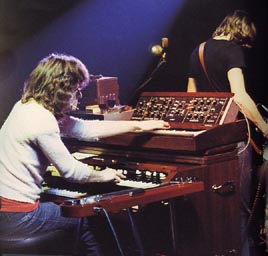 Rick Wright (left) and Roger Waters. |
Taking this new work on the road, the US tour in September 1972 actually gives us a busier piano. The song has the same structure as the album, but Wright is evidently trying out different things and frequently puts in more twinkles with his fingers. Very faintly, almost nonchalantly, there is a sort of solo, a cross between a keyboard and a clarinet being played in the vast emptiness that would eventually be filled with vocals. All I can do is wonder why they didn't try Gilmour out on guitar. The progression of this solo follows what Torry would later come up with; or at least what the band mixed her vocals into. After this bass-heavy, lightly-soloed middle section, the track flows on with some free and easy piano work following the same structure with a light tempo from Nick, again fading out to the intermittent cash jingles as Money comes in.
By November 1972, as Pink Floyd ventured through Europe, the religious tape effects had made a brief comeback, with the new piano piece as its backing track. Maybe because it's a better piece of music, or maybe because it is simply more musical than the early 1972 keyboards, the religious speeches actually sound far more effective in this new setting. But not effective enough for the band, it would seem, as they didn't last long; although a variation of them were revamped for the 1974 tours as part of the new piece, "Raving and Drooling". By December, as they continued to tour throughout Europe, the track had reverted to what was being played in September. It is only speculation, but is there a chance that somehow, the vocal tapes from the November shows did stay in Roger Waters' mind for this music, eventually germinating as the now-famous vocal sound bites scattered through out Dark Side?
With studio time in front of them, and a few performances with the Roland Petit Ballet to help relieve the focus on the new album, the band had time to put the finishing touches on each track. It was then, in those first few weeks of 1973 that the efforts of Clare Torry would be realised. This is the point when the music changed from being the highlight to being the vehicle.
The Butterfly
"The Great Gig in the Sky": March 1973 and beyond
Nick Mason explained that other singers were considered for the task, including the mezzo-soprano Cathy Berberian, as they were looking for a more European sound to the vocal instead of the soul sound the album's other backing vocalists had provided. But ultimately, through a recommendation from Alan Parsons, Clare Torry was invited to perform the duty.
Speaking for the Classic Albums series, Rick Wright explained, "we knew that we wanted someone to just improvise over this piece. So we directed her and we said 'well, think about death, think about horror, think whatever and just go and sing'. And my memory is that she went out to the studio and did it very, very quickly and then came back in and said 'I'm really sorry about this', very embarrassed. And we were in fact sitting in the studio saying 'this is wonderful'."
Roger Waters: "And of course it's absolutely brilliant. Both, both Rick's piano and organ work and Clare's singing is just incredibly moving."
Worthy of note at this point is a smaller piece within the music; hidden, as it were, behind the piano and vocal is the slide guitar of David Gilmour. And although it is good to listen to on the original track, the DVD release of the Classic Albums series featuring The Dark Side of the Moon has a list of bonus materials, including Gilmour playing just the slide guitar. Some would argue that this, along with some of the other bonus material, is worth the price for disc.
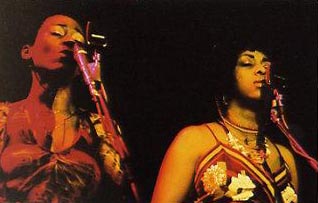 The Blackberries (Venetta Fields and Carlena Williams) toured with the Floyd, providing vocals for Dark Side songs. |
By March 1973, Pink Floyd were again on tour in the US, and Dark Side was the second set of the show, where it would stay for the next few years. The album was still a couple of weeks away from release, so it remained largely unknown. This rendition of "The Great Gig in the Sky" would be unknown even to the few up-to-date bootleggers familiar with the late '72 shows. The live version now closely matched the studio recording, including Clare Torry's as yet unheard vocals, so the impact it must have had on the audience can only be guessed at. The efforts of Venetta Fields and Carlena Williams (a.k.a. The Blackberries) are certainly notable, as they would have been working off the album copy and trying to bring their own take on it as well. A commendable job, but there do seem to be a lot more "yeahs" than "ohs" and "woos". Maybe it's that 'soul sound' that Mason was describing.
For me, this journey of growth and change ends at this point in early 1973. By June, as the band embarked on yet another US tour, the track had ballooned to over six minutes, the ending dragging out for an eternity. Sadly, this was something the band thought was a good idea and basically stuck with. I can only think it a blessing that a side of vinyl was restricted to twenty odd minutes and so they had to keep it short! The piece was played as part of the whole album through to 1975 and revived in 1988 when Pink Floyd ventured out again. It appeared in the Delicate Sound of Thunder video with a rather lovely backdrop of Versailles. Roger Waters also managed a couple of versions at Wembley Arena in 1987, featuring Clare Torry as a guest vocalist. (The most dreadful performance of the piece unfortunately also belongs to Torry as she guested with Pink Floyd at the Knebworth Festival in 1990. It is generally accepted that this is a low point in not only this show but for this song. Some fans consider it the Floyd's worst onstage moment ever; a harsh call indeed.) Great Gig was a staple during the Division Bell shows in 1994, and again Roger Waters played it during his 1999-2002 In the Flesh tour. He did however play it more as a tease, cutting it short after a minute or so, using it as an outro to "Breathe (reprise)".
I do feel however, that it is all these latter performances that have tarnished the song for me. For me, from late 1972 to early 1973 (culminating with the album) are the highlight dates for this piece of music, and perhaps even for the band themselves, as they pushed the envelope to ultimately create one of the greatest albums of all time. A lot of the music on The Dark Side of the Moon is fairly recognisable from the beginning to the end of its' journey. But the journey of The Great Gig in the Sky" is another matter, and one certainly worth taking.
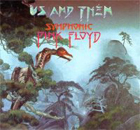 Us and Them - Symphonic Pink Floyd |
At times, yes. In "Time", for instance, the verses sung by Rick Wright are nicely orchestrated, with flute and oboe recreating the gentle mood. The choruses of "Comfortably Numb" are fairly close to the original arrangement, and the verses seem to fit orchestral setting better than the average rock melody. The opening strains of "The Great Gig in the Sky" feature a convincing adaptation of the piano track for the string section. "Breathe" begins with an arrangement that is appropriately bold and dramatic.
Unfortunately, most of these tracks fall apart after a few minutes. When the violin section tries to recreate Gilmour's searing guitar solo from "Time" or Clare Torry's transcendent vocal performance on "Great Gig", you can't help but cringe in horror. "Breathe" can't sustain the momentum of its bold opening, and quickly becomes bogged down by overly-busy background figures. "Comfortably Numb", in the final assessment, comes off as dull background music. It isn't bad, but it lacks the drama and depth needed to really sustain interest.
Rock music is, after all, fairly repetitive, and without the lyrics or the solos to sustain audience interest, these classical interpretations just flounder. "Another Brick in the Wall" doesn't really attempt to be any particular part of the song, but instead, they build a rather dull and meandering piece almost entirely around the familiar four-note melody. (And to make it worse, it goes on for eight-and-a-half minutes. Nevermind that even the Floyd's versions get tedious at this length.)
In "Brain Damage", I find myself missing the guitar parts that drive the song along. Instead of those lilting, repetitive guitar figures, we have soft, pulsating arpeggios. The chorus is even worse as the melody is lost entirely, though the chord progression is easily recognized. There are trumpet countermelodies that aren't quite what the doctor ordered. It might make a passable backing track, perhaps, if there were a guitar and vocal singing the lyrics. However, as a standalone piece, it lacks drama.
In the final assessment, Us and Them - Symphonic Pink Floyd is disappointing and utterly forgettable. I could also complain that the record ends up being a tribute to Dark Side, rather than a tribute to the entire scope of the Floyd. After all, there are a total of three non-Dark Side songs, and these all come from The Wall. (Was the entire project conceived by a marketing agency?) But I imagine that I wouldn't be happy if they given this same treatment to a bunch of obscure songs, either.
Orchestral Maneuvers: The Music of Pink Floyd
Arranger David Palmer has released a set of orchestral Floyd arrangements twice: first under the title Objects of Fantasy, and later under the title Orchestral Maneuvers: The Music of Pink Floyd. Don't be confused; these are the exact same recordings. Palmer, formerly of Jethro Tull, has done a number of orchestral 'tributes' to various rock acts, including the Beatles, Queen, and Tull itself. (He has also undergone a sex change operation, and is now called Dee Palmer.)
Palmer's Floyd tribute (which features the Royal Philharmonic Orchestra) takes a decidedly different approach than Us and Them. Rather than reinterpreting the originals in the classical style, he has mainly chosen to fit the orchestra into a rock band. Most of the arrangements feature guitar, bass, and drums, with the orchestra supplementing the rhythm section and carrying the melody. A few of the tracks even feature vocalists, with the orchestra reduced to a background role.
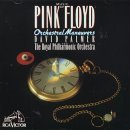 Orchestral Maneuvers: The Music of Pink Floyd |
The result is a much more accessible album that embraces the music's rock origins. Unfortunately, it sometimes leaves you wondering why he bothered. I mean, if I want to hear a rock band playing faithful renditions of Floyd music, I can listen to the Floyd, thank you very much.
"Money", for instance, is faithful to the original: drums, bass, guitar, electric piano, even recorded cash register sounds. The orchestra plays the melody (badly) and accentuates the basic rhythm track in much the same way that the guitar and keyboards do on the original. But saxophone and guitar solos are hardly the sort of things you buy an 'orchestral' album to hear, especially when they aren't anywhere near as good as the solos on the original recordings. "Hey You" is really great... through the first verse. Then on the second verse, they let the guitarist play the melody, and it becomes disappointing. The orchestra parts are actually pretty good, although it sounds like little more than a backing track for a singer. Floyd karaoke, anyone?
Even sections that you might think would be a great opportunity for the orchestra to shine--such as the opening riff of "Run Like Hell", which seems like a perfect trumpet fanfare--fail to live up to expectations. "Wish You Were Here" seems like it would be a natural for an orchestra, with its lyrical melody and flowing structure. The arrangement presented here, however, overshadows the calm beauty of the melody with a frantic, pulsating background figure, and adds heavy drums, weighty brass, and pounding tympani flourishes. It wrecks one of the Floyd's most-loved songs.
"Goodbye Blue Sky" is a nice choice for a couple of reasons. For starters, it isn't the one of the 'greatest hits' song you usually find on this kind of album. And second, it certainly seems like the perfect kind of gentle song for an orchestra. The arrangement is very much like the Floyd version--acoustic guitar and vocals (a choir, with soloists). There are some orchestral backgrounds, but so what? This kind of thing turns up on rock albums all the time. The net effect is something like "The Moody Blues Play Pink Floyd"... poorly. Ditto for "On the Turning Away". The flute/piccolo in the first verse give the simple tune a colonial folk-song feel, but then the orchestra is left doing little more than backing up the rock band.
Finally, at the end of the album there are two shining moments. The first comes on "Shine On You Crazy Diamond", which could certainly work as an orchestral piece even in the Floyd's arrangement. The introduction here is somewhat jazzy, and isn't even really recognizable at first. For the first two-and-a-half minutes, the track really works well, with lovely soprano saxophone playing the familiar melody of the verse. Then Syd's theme comes in, and the arrangement follows the pattern laid out in the Floyd version. Somehow it just doesn't live up to the promise of the first section. Perhaps it is too close to the original arrangement, with the orchestra playing the synth parts and some of the guitar lines. It doesn't seem new, but rather a pale shadow of the original's glory. It isn't bad (in fact it is generally less jarring and unpleasant than most of the tracks reviewed thus far) but it isn't spectacular either.
"When the Tigers Broke Free" is another surprising--and welcome--choice for the track list. On first listen, you can't help but feel that this is finally a perfect marriage of orchestral arrangement and the Floyd music we love so much, even with a fair forgery of Waters' raspy vocals. Then it hits you--this works so well because it is almost identical to the original version, which is orchestral to begin with! Oh, well. I guess the Floyd got it right the first time. Still, the song then leads into a nice rendition of the "In the Flesh" riff (or is that the repeated theme from Pros and Cons?) before wrapping up with "Eclipse". It's a nice touch, since the orchestra adds a certain amount of gravity to the music and the lyrics.
So, after two albums, we have a total of two tracks worth hearing: two-and-a-half minutes of "Shine On" (or perhaps the full ten minutes if your expectations aren't too high), and a nice medley of "When the Tigers Broke Free" and "Eclipse".
The String Quartet Tribute to Pink Floyd
Recently, a group calling themselves "The String Quartet" has been doing a series of tribute albums playing quasi-classical versions of classic rock acts such as Led Zeppelin and The Who, as well as more modern (and diverse) artists like Radiohead, Weezer, and Incubus. They also released a tribute to the Floyd in 2002 (as well as a string quartet rendition of Dark Side in its entirety, not reviewed here). Now, a string quartet isn't a full orchestra by any means. (For anyone not particularly well-versed in such things, a string quartet is usually two violins, a viola, and a cello, while a full orchestra would have several of each of these, plus trumpets, trombones, tubas, flutes, clarinets, percussion, and so on.) This isn't exactly a traditional string quartet. For starters, there are five players listed, including an acoustic guitarist and a bassist.
But this is still an attempt to do some kind of classical versions of the Floyd's music, so it's worth a look.
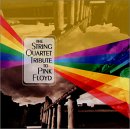 The String Quartet Tribute to Pink Floyd |
"Echoes" is the first track, which is surprising because it isn't the kind of thing the average radio Floyd fan is going to be familiar with. Unfortunately, the arrangement is fairly disappointing. The opening 'pings' are performed via plucked violin strings in a pizzicato style, and the first minute or so isn't really recognizable. Once the melody comes in, you keep thinking 'wow, this could really work'. But the harmonies in the violins are all wrong (after Gilmour and Wright did such a great job of harmonizing on the record, why wouldn't you just replicate this?) and grate on the ears quite a bit. Being limited to four or five voices, the song can't really build to the dramatic moments as effectively as we have come to expect from the Floyd's version.
I guess what I was hoping for was something transcendent, something that stands upon its own merits as an classical arrangement, rather than something that only makes me long for the original even more. Though they do a nice job varying the arrangement, you can't help but think of this song as little more than a novelty recording, something done just to attract the attention of the hardcore Floyd fan. I'll admit that in my case it worked, as the track list was definitely what inspired me to buy the CD rather than just put it back on the rack and keep browsing.
"Have a Cigar" is even less successful. The Floyd version is so heavy and angry. Frankly, it is difficult for a string quartet to carry that kind of emotional weight. Add to that the fact that the basic riff and the melody in the verses are monotonous--something you can overlook when focusing on the song's message. Stripped of the lyrics, it just sounds like a telegraph ticking out Morse code. Still, the moving lines ("riding the gravy train") are nicely done.
Then comes "Take Up Thy Stethoscope and Walk", blowing all of my earlier assertions away. Yes, it is repetitive and monotonous, and no, it can't hold a candle to the power of a genuine psychedelic rock band. But it is frantic and frenetic--and wonderful. It is exactly the wrong kind of music for a string quartet to tackle, which makes it perfect. The louder you play it, the better it sounds. It makes you want to hunt down Hans Keller and play it until he admits that even string quartets can sound good when played loudly enough.
"Hey You" succeeds by recreating the arpeggio backgrounds and soothing melodic figures of the original. More than any of the preceding tracks, this sounds (mostly) like something that was composed with this kind of ensemble in mind. "Comfortably Numb" also works in the quartet setting despite becoming awfully monotonous after a few minutes. The gentle sections are suitably gentle, but I find myself missing that heavier section too. (I guess Gilmour was right on that score.)
"Money". Yes, another version of "Money". It really does get tiresome. But imagine how the Floyds themselves must feel about it, having played it so many, many times, and to have people still clamoring for it. This is fairly faithful to the original, and I suppose that the radio-fans that bought this album dig it. There's nothing really wrong with it, and nothing specific to dislike, other than the fact that it is "Money". Again.
"Breathe", on the other hand, is so different as to be almost unrecognizable at times. It certainly sounds like 'legitimate' string quartet music, and with some minor tweaking (such as abandoning the pulsating guitar) could probably be played in a concert hall without too many people immediately noticing that this was that 'vulgar' rock music.
No one, however, would mistake "Another Brick in the Wall" for chamber music. The guitar plucks out the familiar rhythm figure over the familiar bass line, and the other instruments muddle their way through the same old melody. This song, like "Money", simply has to be the bane of any Floyd tribute. There is no reason for a string quartet to play this song except for the novelty of it, and because it is absolutely expected of any tribute to the Floyd.
"Wish You Were Here" is a sweet little arrangement that works well within the confines of the quartet's sound, without forcing them into the unfamiliar ground of rock and without forcing the Floyd's music to fit into a bizarre structure. (Compared to the Floyd's version, it is a little lightweight. But compared to the horrendous bastardization found on the Orchestral Maneuvers album, this is perhaps the crowning achievement in the history of music.)
There are other orchestral Floyd tributes, such as The Royal Philharmonic Orchestra Plays Hits of Pink Floyd. (One can only hope that they haven't re-recorded David/Dee Palmer's earlier orchestrations.) Frankly, I don't have the energy or the desire to hunt them down. This kind of thing is really mostly interesting as a novelty, a nice breath of fresh air once in a while. If the best of the orchestral Floyd tribute albums could be described as merely a somewhat-successful, not-entirely-unpleasant novelty record, I would have to say that the genre is probably one worth retiring entirely.
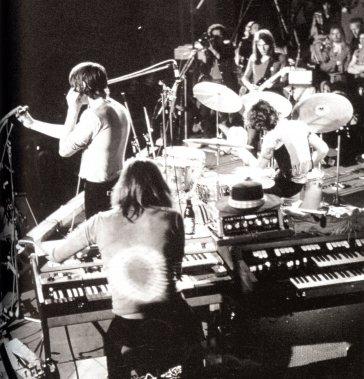 The Floyd performing at the 1970 Holland Pop Festival. |
If ever I was to build a time machine, I would make regular visits to this performance. Of all the Pink Floyd performances I have heard, seen, and read about, the Holland Pop Festival show is by far their best. This is all based on a very poor recording I have of the show and footage of the band performing part of "A Saucerful of Secrets". The fact that that footage is what is on the Stomping Ground film makes it even worse for me as it means there is a great chance their whole performance was filmed, and a fairly good chance that that film is out there somewhere in the hands of either the owner or a collector. Maybe one day we'll see it all. Very little has been written about the performance by either critics or fans, so I have no insight into what it might have been like being there. But we do know what we hear and see.
It was this film that properly brought "A Saucerful of Secrets" to my attention. In that footage, not only do they play along, but they really get into it. In the 'Celestial Voices' climax to the song, as they repeat the progression for a suitable eternity, the four of them begin to watch each other and openly encourage each other to keep going, to really push it, which they do, with Waters, the conductor, yelling for one more, the band closely knit. (This scene also tells me that a long time ago, these four musicians were good mates who had that unseen connection on stage--and in the studio--that most other bands can only dream about.) And then at last they crumple and pull up. It is a stunning performance, as is the whole concert, to say the least.
27 June 1970 Bath Festival, Bath, England
The Bath Festival show, performed the night before the Holland Pop Festival (the organisers contracted the bands for both festivals), clearly shows that Pink Floyd were in good form the night before as well. The version of "Saucerful" at the Bath Festival covers many of the key criteria, and better still, we actually have a good recoding of it too. However, to prevent ranting for too long, the highlight of this performance by a long way is the efforts of David Gilmour during 'Storm Signal.
22 September 1972: Hollywood Bowl, Hollywood, Los Angeles, California, USA
In this legendary performance, Mason gets faster and faster throughout 'Storm Signal', building the intensity to yet another level. Gilmour is on fire throughout, but it is extra special at the 7-8 minute mark. And best of all, there are two repetitions of the vocals at the end, finished off with fireworks! This show was so memorable for the band, Nick Mason explains that it later became an inspiration for the staging of the Division Bell tour.
29 April 1970: Fillmore West, San Francisco, California, USA
Leading into the 'Storm Signal', the band offer a huge teaser and it is very cool that they keep up for another minute and a half. When they do finally get there, it is a seriously demented 'Storm Signal' indeed. Nice keyboard work outside of the main theme of 'Celestial Voices' is an added bonus.
17 October 1970: Pepperland Auditorium, San Raphael, California, USA
Serious slide guitar at the end of 'Syncopated Pandemonium' blending into dueling between Gilmour and Wright as the slide changes into that harsher ripping throughout 'Storm Signal'. At aronnd 9 minutes, there is a rise in everything as all four go to town, holding it there for a breathtaking two minutes. Then two more minutes of next to nothing, just intermittent wailing as the audience sits waiting for 'Celestial Voices'. Very cool slide from Gilmour starting around 15:30. And then to show that even imperfect versions of this song are still worth the effort, the sound blows at the 18+ minute mark. It staggers back a few moments later but without vocals for a while. And then it goes again! It must have been irksome having gotten that far, for venues to let them down through poor power supply! But still a great moment.
18 September 1971: Montreux, Switzerland
Heavy on the keys for 'Syncopated Pandemonium' is a stand out difference, and suitable surprise. It delayed 'Storm Signal' to the 5+ min mark which was also rare, but the few times the band does it, it always makes for a better performance. There is more flowing, rolling, and rumbling to Gimlour's guitar work, a clear and crisp pleasure. The first hints of 'Celestial Voices' come in at the 10-minute mark, as though Wright is testing the keys for the right sound. Again at 11 minutes Wright teases, but finally at 13 minutes 'Celestial Voices' takes control. It is slower than normal (might be the tape?) but that makes for a very dramatic performance indeed.
And lastly, a quick mention of two performances even though they are intentionally incomplete: 14 April 1969 Royal Festival Hall, London, and 17 Sept 1969 Concertgebouw, Amsterdam. These shows have very tasty versions of 'Celestial Voices' as part The Journey suite, simply because Rick Wright gets to use a pipe organ. This gives it a wonderful richness and fullness that only churches (and concert halls) seem to manage.
In conclusion, let me take off my small and shabby "journalist" hat and replace it with my rich, plump, oversized, and fearsomely pompous "fan" hat. This one song, time and again, irrespective of the version and its quality, not only makes me take a breath, but makes me take a look at life itself. And to be honest, I have no idea why. There are versions that make me laugh, and versions that make me cry. It is stunning and invigorating, and inspirational, and just plain beautiful. And pardon the really bad pun, it truly is a Saucerful of Secrets.